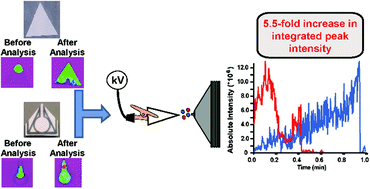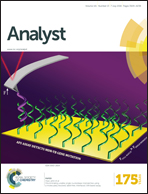Improving the analytical performance and versatility of paper spray mass spectrometry via paper microfluidics†
Abstract
Two paper-based microfluidic techniques, photolithography and wax patterning, were investigated for their potential to improve upon the sensitivity, reproducibility, and versatility of paper spray mass spectrometry. The main limitation of photolithography was the significant signal (approximately three orders of magnitude) above background which was attributed to the chemicals used in the photoresist process. Hydrophobic barriers created via wax patterning were discovered to have approximately 2 orders of magnitude less background signal compared to analogous barriers created using photolithography. A minimum printed wax barrier thickness of approximately 0.3 mm was necessary to consistently retain commonly used paper spray solvents (1 : 1 water : acetonitrile/methanol) and avoid leakage. Constricting capillary flow via wax-printed channels yielded both a significant increase in signal and detection time for detection of model analytes. This signal increase, which was attributed to restricting the radial flow of analyte/solvent on paper (i.e., a concentrating effect), afforded a significant increase in sensitivity (p ≪ 0.05) for the detection of pesticides spiked into residential tap water using a five-point calibration curve. Finally, unique mixing designs using wax patterning can be envisioned to perform on-paper analyte derivatization.


 Please wait while we load your content...
Please wait while we load your content...